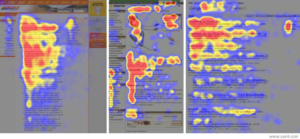Call us on 01273 757996
There is one sure-fire way to ensure your web copy is not read: you simply take your printed brochure and place the words from it up on your site.
The truth is that we read web sites in a different way to how we read books or brochures.
- If we can get our heads around this we can start to get our website copy actually read.
• If we can get our site read we can start to get our sales messages across.
Here is how to write web copy that converts.
The scanning eye
A heat map is a tool researchers use to record how people’s eyes behave when they look at a screen.
It shows how the eye darts, where the eye lingers and what the eye skips over. It shows what attracts the eye and what makes it (literally) look away.
Heat maps show, time and time again, that we scan, rather than read, websites.
The typical website reader skims a web page, pausing only on things that interest it or arrest its attention.
The typical pattern that heat maps form is known as the F-pattern.
- The eye focusses on the first few sentences
• It then quickly trails down the left side as it searches for relevant info
• If it finds anything interesting there will be areas near the middle of the page where it lingers
The three examples below are taken from three different pages.
- An About Us page
2. A product sales page
3. A search engine results page
On each of these pages, however, the F-pattern can be seen.

Source: Nielsen Norman Group
Let’s look a little closer, however.
Notice how the product page (centre) and the results page (right) contain writing whose text is broken into chunks. The scanning eye says thank-you very much and rewards them with good coverage.
Now take a look at those large sections of non-stop text that make up the About Us page: the eye tries to read and then shuts down, leaving all that carefully crafted prose untouched.
The best place to start, if you actually want your web copy to be read, is with the foibles of the scanning eye and this is how you can serve the scan.
Serving the scan
Bullet points (or numbered lists) help to:
• Break up blocks of text
• Make key points stick out
• Keep everything to the left-side, which is where the eye scans
Another great way to provide those breaks the scanning eye loves is with short, punchy paragraphs.
Images or videos will:
• Help to break the copy up
• Stress key points visually
• Provide the eye with a ‘natural’ place to linger
Formatting
The scanning eye stops when things look different.
Use bold, underlines, font sizes or italics to make things stand out. This is particularly important for headings which help section off your copy and indicate the key point of what follows.
Say your important point first
Before you sit down to write any web copy be clear about the key takeaway that you want visitors to leave with.
Now try and say it in the very first sentence and allude to it in your heading. If you can’t do this, always place your important point in bold.
Is anyone acting on your copy?
Of course, getting someone to read your copy is one thing. Getting them to act on it is another altogether.
But that is another story.
If you are struggling with a high bounce rate, or convinced that you are not getting your message across online, give us a call to talk through your problems. Similarly we’d love to hear your web copy solutions and any success stories you’d care to share.